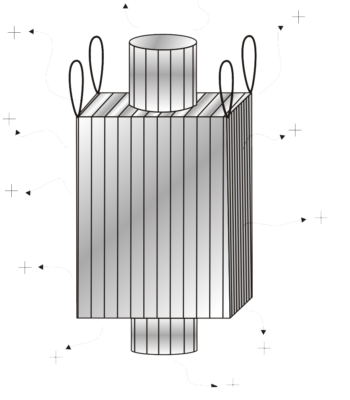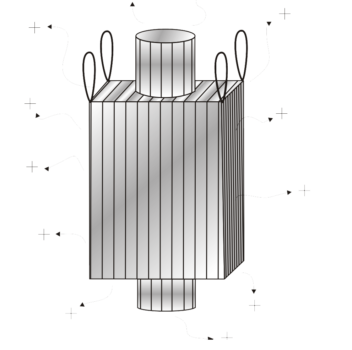Type D Bags (Dissipative Bags)
Dissipative FIBC Bags

Dissipative FIBC Bags
Made of a special antistatic fabric, the anti-static bulk bag at Rishi FIBC comes with permanent discharged properties and is designed to prevent the occurrence of flammable sparks, brush discharges and propagating brush discharges without connecting the bulk bag to ground or earth.
The reason for this is that the dissipative FIBC bag does not require grounding or earthing which means no interconnection is required either. A safe dissipation of static electricity in the atmosphere is possible via low-energy corona discharge as these dissipative FIBC bags are made up of fabric that contains quasi-conductive yarns.
These FIBC antistatic type D bags at Rishi FIBC are designed to guarantee protection against unforeseen electrostatic hazards as the risks related to human errors are eliminated with the manufacturing and use of grounded Type C FIBC.
The Type D FIBC bag is been safely and successfully used to pack materials like foods, chemicals, pharmaceuticals, minerals, pigments as well as other products.
Why Choose Type D (Dissipative) FIBC Bags?
- Enhanced safety: Type D FIBC bags are designed to safely handle combustible materials without the need for a ground connection, which eliminates the risk of static electricity buildup during filling and emptying operations. This can help reduce the risk of fire or explosion in the workplace.
- Versatility: Type D FIBC bags can be used in a wide range of applications where combustible materials are involved, including the pharmaceutical, chemical, and food industries.
- Cost-effectiveness: Type D FIBC bags can be a cost-effective solution for companies that need to handle combustible materials but don’t want to invest in expensive equipment or infrastructure to manage static electricity.
- Compliance: Using Type D FIBC bags can help companies comply with industry standards and regulations that require the safe handling of combustible materials.
- Convenience: Type D FIBC bags are easy to use and can be transported and stored efficiently, which can save time and money for businesses.
- Enhanced safety: Type D FIBC bags are designed to safely handle combustible materials without the need for a ground connection, which reduces the risk of fire or explosion in the workplace.
- Versatility: Type D FIBC bags can be used in a wide range of applications where combustible materials are involved, including the pharmaceutical, chemical, and food industries.
- Compliance: Using Type D FIBC bags can help companies comply with industry standards and regulations that require safe handling of combustible materials.
- Cost-effectiveness: Type D FIBC bags can be a cost-effective solution for companies that need to handle combustible materials but don’t want to invest in expensive equipment or infrastructure to manage static electricity.
- Durability: Type D FIBC bags are made using high-quality materials that are designed to withstand the rigors of handling and transportation.
- Convenience: Type D FIBC bags are easy to use and can be transported and stored efficiently, which can save time and money for businesses.
- Environmental friendliness: Type D FIBC bags can be made using recyclable materials, which can help reduce waste and promote sustainability.
Overall, Type D FIBC bags offer a safe, versatile, and cost-effective solution for handling combustible materials in a variety of industries.
- Chemical industry: Type D FIBC bags are often used for the safe handling and transportation of combustible chemicals such as powders, resins, and pigments.
- Pharmaceutical industry: Type D FIBC bags are used for the safe handling and transportation of combustible pharmaceutical materials such as powders, granules, and capsules.
- Food industry: Type D FIBC bags are used for the safe handling and transportation of combustible food materials such as flour, sugar, and starch.
- Agricultural industry: Type D FIBC bags are used for the safe handling and transportation of combustible agricultural materials such as fertilizers, grains, and seeds.
- Mining industry: Type D FIBC bags are used for the safe handling and transportation of combustible mining materials such as minerals and ores.
- Energy industry: Type D FIBC bags are used for the safe handling and transportation of combustible energy materials such as coal, biomass, and fuel pellets.
Overall, Type D FIBC bags are a versatile solution for handling and transporting combustible materials in a wide range of industries.
- The antistatic Type D bags are safe to use to transport the flammable powders and even when the flammable solvents or gases are present in the environment and around the bag.
- It is wise to not use the Type D FIBC bag when conductive materials like water or grease are coated or contaminated on the surface.








